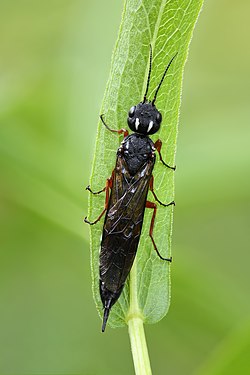| Xiphydriidae Temporal range: | |
|---|---|
 | |
 | |
| Xiphydria type genus of the family Xiphydriidae | |
| Scientific classification | |
| Kingdom: | Animalia |
| Phylum: | Arthropoda |
| Class: | Insecta |
| Order: | Hymenoptera |
| Superfamily: | Xiphydrioidea |
| Family: | Xiphydriidae Leach, 1815 |
Xiphydriidae are a family of wood wasps that includes around 150 species. They are located all over the world including North and South America, Australia, Europe, and others. [1] Xiphydriidae larvae are wood borers in dead trees or branches of a range of trees. [2] They are characterized as having long and skinny necks with dome-shaped heads. [3] [4] The oldest fossils of the group are from the mid Cretaceous. [5]
